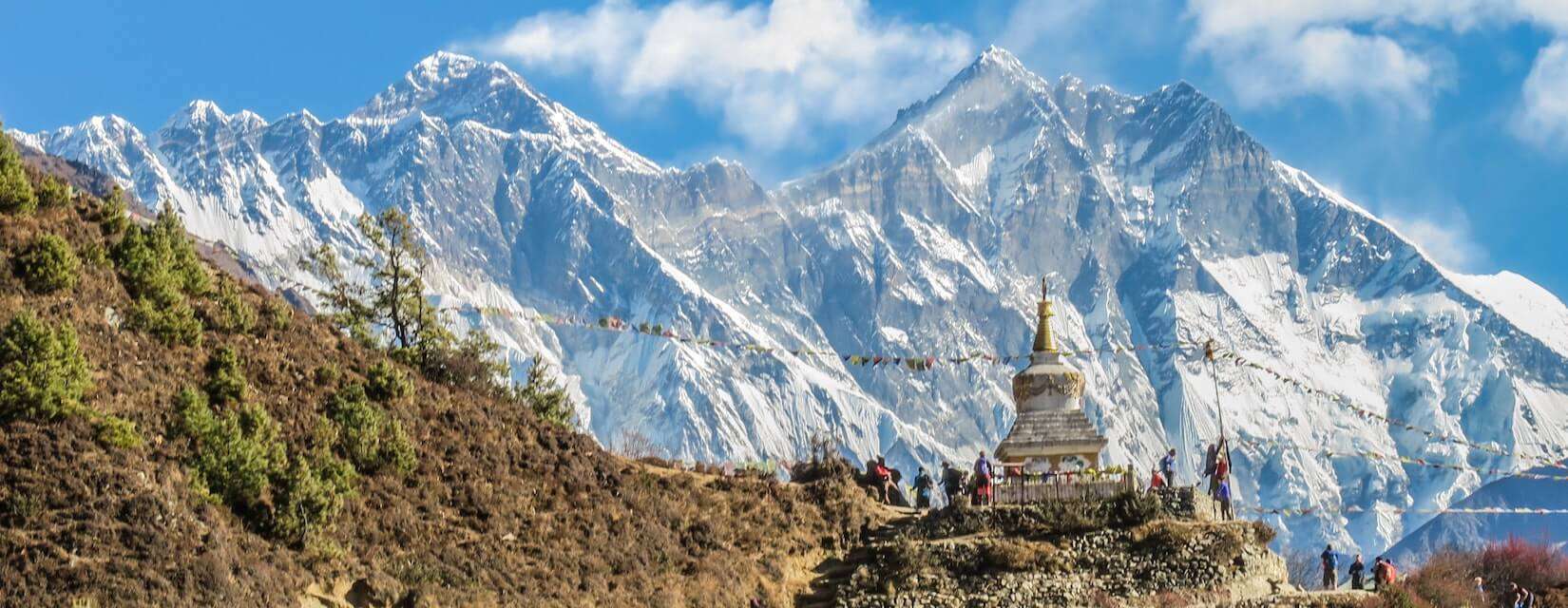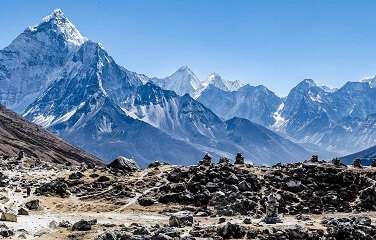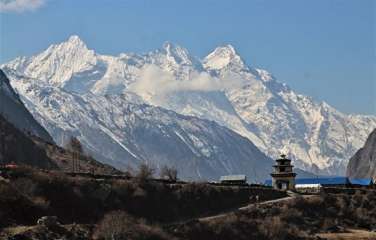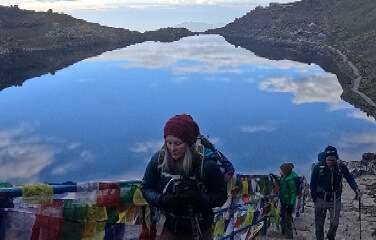Everest Base Camp Trek Route

Everest Base Camp Trek Itinerary begins from Lukla (Gateway to Khumbu Valley Mount Everest region) after the scenic mountain flight from (UNESCO listed World Heritage site) Kathmandu, then you walk through the bank of deep Dudhkoshi river valley, green moving slopes, farmland, rhododendron & alpine forests, and cross the long suspension bridge of Khumbu Khola. Similarly, the Everest Base Camp Trek route crosses the beautiful Sherpa valleys of Phakding, Namche Bazaar, Tengboche, Dingboche, and Gorak Shep. The next day reaches the Everest base camp and is ready to see the jaw-dropping, picturesque landscape, the massive and magnificent Himalayas. There you have again a great opportunity to hike Kalapathar (5,545m), which is the best viewpoint of the Everest range and has amazing sunrise views. Likewise, the trek descends Pheriche, Namche Bazaar, Lukla, and the flight to Kathmandu.
Everest Base Camp Trek Highlights
- Mountain flight to Lukla from Kathmandu.
- The highest and ancient Tengboche Monastery.
- World's highest mountain, Mount Everest (8,848m) close view.
- Amazing sunrise and Panorama Everest range views from Kalapathar (5,545m).
- Sherpa's unique traditional culture with warm hospitality.
- mesmerizing landscapes of the Khumbu Valley Everest region.
- Wonderful Khumbu glacier and icefalls.
- Magnification Himalayan views of Everest, Lhotse, Nuptse, Amadablam, Thamserku, and more peaks.
- Explore the UNESCO-listed World Heritage site Sagarmatha National Park home to hundreds of rich flora and fauna.
Everest base camp trek itinerary

Day 1: Welcome to Kathmandu!
Kathmandu – 1,300 m / 4,265 ft
Day 2: Kathmandu to Lukla (Flight) to Phakding
Phakding – 2,651 m / 8,697 ft – 4 hrs
Day 3: Phakding to Namche
Namche – 3,440 m / 11,286 ft – 5 to 6 hrs
Day 4: Acclimatization Day in Namche
Namche – 3,700 m / 12,139 ft – 4 to 5 hrs
Day 5: Namche to Tengboche
Tengboche – 3,956 m / 12,979 ft – 5 to 6 hrs
Day 6: Tengboche to Dingboche
Dingboche – 4,380 m / 14,370 ft – 4 to 5 hrs
Day 7: Acclimatization Day in Dingboche
Dingboche – 4,380 m / 14,370 ft – 3 to 4 hrs
Day 8: Dingboche to Lobuche
Lobuche – 4,938 m / 16,200 ft – 4 to 5 hrs
Day 9: Lobuche to Gorakshep (Afternoon hike to Kalapatthar)
Gorakshep – 5160 m / 16929 ft – 6 to 7 hrs
Day 10: Gorakshep to Pheriche (Morning hike to EBC)
Pheriche – 4,371 m / 14,340 ft – 8 to 9 hrs
Day 11: Pheriche to Namche
Namche – 3,440 m / 11,286 ft – 6 to 7 hrs
Day 12: Namche to Lukla
Lukla – 2,860 m / 9,383 ft -7 hr
Day 13: Lukla to Kathmandu (Flight)
Kathmandu – 30 min
Day 14: Departure
Departure
Everest Base Camp Trek Difficulty

Everest Base Camp Trek Difficulty, EBC Trek is one of the most popular adventure trekking destinations in the world, it's the best achievement award for natural lovers. The journey teaches the meaning of determination and patience. Everest Base Camp Trek route walk through the hanging bridges, raging rivers, waterfalls, dense forests, magnification mountain views, ascend, and descends that make you more difficulty your journey. the Everest base camp trek is difficult through Kala Patthar (5,545m) rock way and Everest Base Camp (5,364m). It's the most challenging adventure trekking in Himalayan Nepal. If your health is fit and already has done a trek above 3000m then, Everest base camp is not difficult for you.
Trek to Everest Base Camp for Novices:
The Everest Base Camp trek can be intimidating for novices. However, you can become an expert in this trekking if you do your homework. Many things may be unfamiliar to you if you are a beginner. You may need to learn how to adapt to many different situations.
There are other harder trekking routes, so if you're a beginner hiker you might think it can be a difficult trek. Don't be misled; the situation can occasionally become unpleasant. Altitude sickness is something you should be worried about. Avoid skipping acclimatization day.
Take your time, move at your own pace, adjust to the environment well, eat more carbohydrates, only bring what is absolutely necessary, and hire a porter or guide from a local organization that is concerned.
Never lose faith in yourself. Keep in mind that the secret to successful trekking is having a strong mindset and being well-prepared.
Altitude sickness at Everest Base Camp, anyone?
On the trek to Everest Base Camp, everyone should be aware of the possibility of altitude sickness. The case may range from minor to serious. While the critical condition may require rescue, the normal condition can usually be treated. It has consistently been the leading cause of trip failure.
The atmospheric pressure and oxygen level are both relatively low as you ascend to a higher altitude. Altitude sickness can strike you if you travel to a higher altitude than you are accustomed to.
High altitude sickness symptoms can include headaches, shortness of breath, nausea, loss of appetite, dizziness, and more. Although terrifying, it can be avoided. The most effective defense against altitude sickness is acclimatization. Additionally, maintaining a healthy diet and staying hydrated can be advantages.
Everest Base Camp Trekking Conditions

In Nepal's upper Himalayan region, the weather can change quickly. The weather can quickly and dramatically change. It is warm for one moment and then suddenly becomes very cold.
However, depending on the time of year you trek, the days can be warm at Everest Base Camp. Summer is not particularly hot. Even though it can get up to 24 degrees Celsius during the day, it can also get down to -20 degrees at night. Therefore, the best times to trek the EBC is in the fall and spring in Nepal.
You can ask your travel companion or do a web search for the latest weather information for the EBC region.
When is the best time to visit Everest Base Camp?
among Nepal's four primary seasons. The spring and fall seasons are the best times to visit Everest Base Camp. It is the time of year when the weather is at its most spectacular and the sky is clear. The view is more rewarding when there is a clear sky.
The other two seasons are winter and monsoon. Rain and storms are the main features of the monsoon. Clouds frequently obscure the views. Compared to other seasons, winter has colder weather. Additionally, snowfall makes hiking more challenging.
It does not, however, imply that trekking is not possible. For some reason, the winter months can be the best because there are fewer people around during the off-season. In December, the sky also becomes clear.
Is travel insurance necessary and required?
Trekkers must have insurance coverage when hiking above 4,500 meters in elevation to reduce the risk of any potential mishaps. The majority of trekkers believe that travel insurance is not required. However, MMT advises you to take out insurance with a licensed insurance provider who will guarantee to pay for the insurance of lost, stolen, or misplaced baggage; compensation for canceled flights; and helicopter evacuation above 6,000 meters in case of a medical emergency in the Himalayan region. Therefore, search online for the best Nepal trekking travel insurance.
Everest Base Camp Trek Cost
The cost of the Everest Base Camp trek is quite flexible. The number of days and services you select will affect the cost of the trek. The level of luxury you desire while trekking can also make a significant difference. A typical package from neighborhood agencies can run you between $1,200 and $1,600.
If you are physically fit and enjoy independent travel, you can finish the trek for as little as $700. Similarly to that, a high-end trek can cost more than $4,500. The cost of Everest Base Camp Trek package will be less expensive if you reserve it in advance. Therefore, you can reserve a trek for the spring (March, April, and May) and autumn (September, October, and November) in 2022, respectively.
Do I need to work out or be in shape before climbing Everest?

The Everest Base Camp Trek is a non-technical trek that can be comfortably completed by physically fit hikers, unlike climbing Everest. 90 days before the trek date, you should establish a routine of regular exercises such as jogging, cycling, swimming, and hiking. Check your health status and any injuries you may have in addition to exercising beforehand to make the trek successful and convenient.
Related trip to the Everest region
- Everest base camp trek via Gokyo lake
- Everest three high passes trek
- Everest base camp trek helicopter return
- Everest panorama view trek





